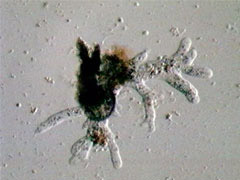Amoeba (Protozoa)
Amoebas are primitive, unicellular animals known by their flowing, free-form movements and their prey capture techniques. Most members of the order Amoebida in the phylum Sarcodina are free-living, but some are endoparasites of plants and animals, and are well known disease vectors of ailments such as amoebic dysentery in humans.

Amoeba Video #1
Cytoplasm of an amoeba is seen flowing into the advancing pseudopods as they extend during movement; under oblique illumination with a playing time of 14 seconds. Choose a playback format that matches your connection speed:
Amoeba Video #2
An amoeba slowly moves around the viewfield by alternately extending and retracting a pair of very long pseudopodia; under oblique illumination with a playing time of 45 seconds. Choose a playback format that matches your connection speed:
Within the order, there are the typical naked amoebas plus several shelled species. In either type, the amoeboids locomote by using their pseudopods (or false feet), which are projected in the direction of movement, and then followed by the rest of the simple organism via flowing cytoplasm (cyclosis). The best-known species is Amoeba proteus, commonly cultured and sold commercially for classroom instruction and research laboratories. In similarity to other single-celled organisms, Amoeba feature a nucleus, a contractile vacuole, a very flexible cell membrane, and cytoplasm.
When suitable prey items such as bacteria or other protists are located via chemotaxis, the pseudopods are extended and encircle the potential food. As the cytoplasm streams to the pseudopods, the phagocytosis is completed and the prey is digested and stored in the new food vacuole. Amoeboids can reproduce by binary fission and possess some powers of regeneration. In a form of asexual reproduction, the pseudopods begin by pulling apart, after which the nuclear material replicates. As the pseudopods' separation progresses, they eventually split the nucleus, and then the cell, into two smaller individuals. Recent research on combating amoebic dysentery and other amoeba-related human diseases has centered on means of stopping the reproducing amoeba from completing division. In some cases, division is not completed, and the cytoplasm rejoins to form a single individual with two nuclei. Observations in the laboratory reveal a phenomenon best described as "midwifery". As an amoeba starts to replicate, other "midwife" amoebas reacting to chemical stimuli, related to the release of sugars, lipids, and protein from the stretching cell membrane, rush to the "birthing" site. The midwife amoebas actually aid the complete division by helping in the pulling process.

